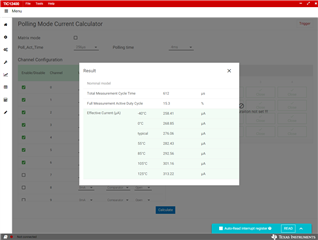Other Parts Discussed in Thread: TIC12400-Q1,
Hi team,
I have a question about the configuration of the TIC10024-Q1(or TIC12400-Q1).
1. Wetting current.
I want to control the wetting current strictly between min 5mA max 10mA, but there is only 5mA or 10mA setting which violate
min 5mA and max 10mA respectively due to its tolerance.
Is there any way to control the wetting current between 5mA to 10mA?
Is it possible to combine 2 (2mA + 5mA) or 3 (2mA x3) INx pins together to increase wetting current?
Or is there any other way using external circuit?
2. Polling time and continuous mode.
Is it possible to combine Polling mode and continuous mode in one device?
For example, IN0 to IN7 is polling mode, IN8 to IN23 is continuous mode?
I would like to minimize current consumption and use polling mode for 6 inputs, but other pins need to detect
switch status in <1ms interval. Because the minimum polling time setting is 2ms, these pins need to read continuous mode.
3. Polling time selection.
3-1. Is there a way to select polling time by Input pins or one polling time setting applies to all input pins?
3-2. Is there a way to configure polling time which is not listed in the register? For example 5ms, 10ms?
regards,
regards,


